Teachers often recommend practicing with AP 10th Class Biology Model Papers and AP 10th Class Biology Question Paper April 2023 to enhance exam readiness.
AP SSC Biology Question Paper April 2023 with Solutions
Time : 2.00 hours
Max. Marks: 50
Instructions :
- Question paper consists of 4 sections and 17 questions.
- Internal choice is available only for Q.no. 12 in section III and for all the questions in section IV.
- In the duration of 2 hours, 15 minutes of time is allotted to read the question paper.
- All answers shall be written in the answer booklet only.
- Answers shall be written neatly and legibly.
SECTION – 1
(6 × 1 = 6 M)
Note :
- Answer all the questions.
- Each question carries 1 mark.
Question 1.
Which vitamin is responsible for clotting of blood ?
Answer:
Vitamin K
Question 2.
Nostrils ⇄ Nasal Cavity ⇄ Pharynx ⇄ Trachea ⇄ Bronchus.
Answer:
Larynx
Question 3.
Observe the given table and answer the question.
| Name of the animal | Weight of the body | Weight of the heart | No. of beats/min. |
| Blue whale | 1,50,000 Kg | 750 Kg | 7 |
| Elephant | 3000 Kg | 12 – 21 Kg | 46 |
| Man | 60 70 Kg | 300 gm | 72 |
| Coaltit (Bird) | 8 gm | 0.15 gm | 1200 |
What is the relation between weight of the heart and rate of heart beat ?
Answer:
Heart beat decreases with the increase of heart weight. /
Heart beat is inversely proportional to heart weight.
![]()
Question 4.
What will happen if insulin production is stopped from pancreas ?
Answer:
Blood sugar levels will be increased /
Glucose will not be converted into glycogen / sugar /
Diabetes or diabetes mellitus disease occurs.
Question 5.
Name the part A in the given diagram.
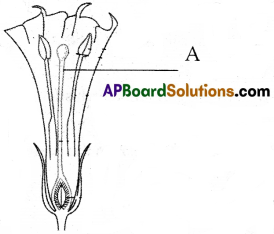
Answer:
Stigma
Question 6.
Write one suggestion to reduce the effects of global warming.
Answer:
- Planting trees.
- Reduce the usage of fossil fuels.
![]()
SECTION – II
(4 × 2 = 8 M)
Question 7.
If you have a chance to meet a nephrologist what questions will you ask to know more about kidney failure ?
Answer:
- What are the major causes of kidney failure ?
- How do you diagnose and treat chronic kidney diseases ?
Question 8.
What is the main function of afferent neurons or sensory neurons ?
Answer:
Sensory neurons or afferent neurons carry messages from sense organs to central nevous sytem (brain or spinal cord).
Question 9.
Fill in the empty boxes (a) and (b).
| Type of teeth | Number | Function |
| 1. ? (a) | 8 | Biting |
| 2. Canines | ? (b) | Tearing |
| 3. Premolars | 8 | Chewing and grinding |
| 4. Molars | 12 | Chewing and grinding |
Answer:
a) Incisors
b) 4
Question 10.
What will happen if the primary consumers decrease in an ecosystem ?
Answer:
- If primary consumers decrease, availability of food decreases for carnivores.
- It results in death of carnivores or may lead to migration into another eco system.
![]()
SECTION – III
(5 × 4 = 20 M)
Note :
- Answer all the questions.
- Each question carries 4 marks.
Question 11.
Draw any food chain with four levels. What are producers and decomposers in a food chain ?
Answer:
Grass → Grasshopper → Frog → Snake.
- In above food chain ‘Grass’ is the producer.
- Decomposers do not occupy a specific level in the food chain.
- They decompose waste and dead matter of organisms.
- Usually ‘Bacteria’ and ‘Fungi’ are known as decomposers.
Question 12.
Draw the diagram of human sperm cell and label the parts.
Answer:
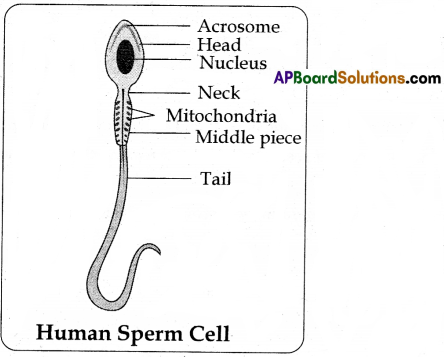
OR
Prepare a block diagram showing water absorption by roots to transpiration by leaf.
Answer:
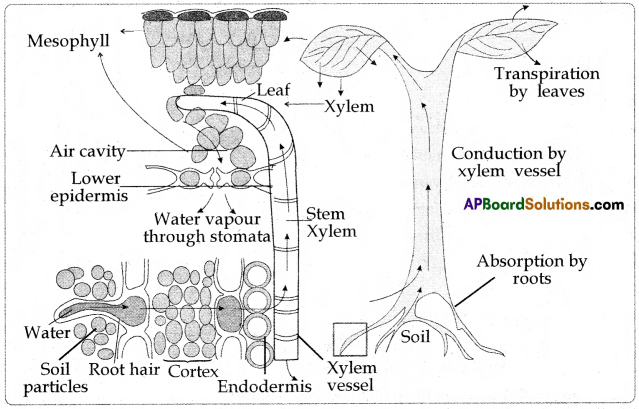
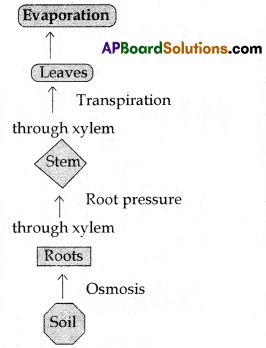
![]()
Question 13.
Write any two phyto hormones and their functions.
Answer:
- Auxins help in cell elongation and differentiation of shoots and roots.
- Cytokinins help in promotion of sprouting of lateral buds, delaying the ageing in leaves, opening of stomata.
- Gibberellins help in germination of seeds, sprouting of buds and elongation of stems and they also help in stimulation of flowering, development of seedless fruits and breaking the dormancy in seeds and buds.
- Abscisic acid helps in closing of stomata, seed dormancy, promoting ageing of leaves.
- Ethylene helps in ripening of fruits.
Question 14.
| ALKALOID | PLANT | PART | USES |
| Quinine | Cinchona officinalis (Cinchona) | Bark | Antimalarial drug |
| Nicotine | Nicotiana tobacum (Tobacco) | Leaves | Insecticide |
| Morphine | Cocaine Papaver somniferum (Opium) | Fruit | Sedative, painkiller |
| Reserpine | Rauwolfia serpentina (Snake root) | Root, bark | Medicine for snake bite |
| Caffeine | Coffea arabica (Coffee Plant) | Seed Central nervous system | stimulant |
| Nimbin | Azadirachta indica (neem) | Seeds, barks, leaves | Antiseptic |
| Scopolamine | Datura stramonium | Fruit, flower | Sedative |
| Pyrethroids | Tridax | Flower | Insecticides |
Observe the above table and answer the following questions :
Question 1.
Which alkaloid is used as medicine for snake bite ?
Answer:
Reserpine
Question 2.
What is the scientific name of neem plant ?
Answer:
Azadirachta indica
Question 3.
From which part of the cinchona plant quinine is obtained ?
Answer:
Bark
Question 4.
What is the use of morphine ?
Answer:
Sedative, painkiller
Question 15.
Write few slogans on conservation of trees.
Answer:
- Plant a tree and save millions of lives.
- Save trees and save our planet.
![]()
SECTION – IV
(2 × 8 = 16 M)
Question 16.
Write the differences between arteries and veins.
Answer:
| Arteries | Veins |
| 1. Walls of arteries are thick. | 1. Walls of veins are thin. |
| 2. Valves are absent. | 2. Valves are present. |
| 3. Carry blood from the heart to body organs. | 3. Carry blood from body organs to the heart. |
| 4. All arteries carry oxygenated blood except pulmonary artery. | 4. All veins carry deoxygenated blood except pulmonary vein. |
| 5. Arteries can retain shape when blood is absent. | 5. Veins can’t retain their shape when blood is absent. |
| 6. Blood pressure is high in arteries. | 6. Blood pressure is low in veins. |
| 7. Arteries end with capillaries. | 7. Veins start with blood capillaries. |
| 8. Arteries are reddish in colour. | 8. Veins are bluish in colour. |
| 9. Arteries have small lumen. | 9. Veins have large lumen. |
(OR)
Explain the process of sex determination in human beings.
Answer:
- There are 23 pairs of chromosomes in humans.
- Of these 23 pairs, 22 pairs are autosomes and these are common both in males and females.
- Remaining one pair is allosomes or sex chromosomes.
- The ova produced by females contain ‘X’ chromosome and the sperm cells produced by the males contain either ‘X1 or 1Y’ chromosomes.
- If the sperm cell which contains ‘X’ chromosome fertilizes with the ovum, the resultant baby will be “Female”.
- f the sperm cell which contains ‘Y’ chromosome fertilizes with the ovum, the resultant baby will be “Male”.
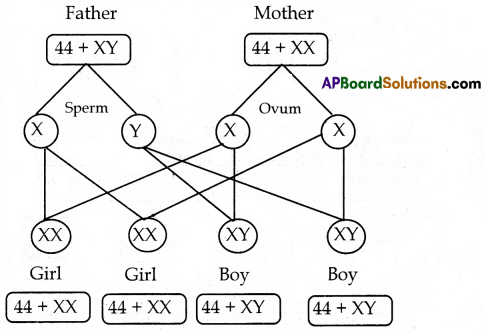
![]()
Question 17.
How do you prove that heat is liberated during respiration ?
Answer:
Aim : To prove that heat is liberated during respiration.
Materials required : Germinating seeds, thermos flask, thermometer.
Procedure :
- Take sprouts in a thermos flask.
- Close the flask with a single hole cork.
- Insert a thermometer through the hole of cork.
- Take care that the bulb of the thermometer should be dipped in the sprouts.
- Record the temperature for every two hours.
Observation:
Temperature in the thermometer is increased.
Result:
It is proved that during respiration of germinating seeds heat is released.
(OR)

Observe the above diagram and answer the following questions :
1) What is the aim of this experiment ?
Answer:
To prove that carbondioxide is essential for photosynthesis.
2) Which solution is taken in the bottle ?
Answer:
Potassium hydroxide / KOH solution.
3) After iodine test, the part of the leaf inside the bottle didn’t turn into blue black colour. Why ?
Answer:
Absence of carbondioxide.
4) Where do we keep the plant before experiment ?
Answer:
Plant has to be kept in dark.